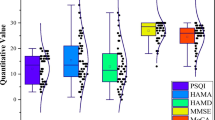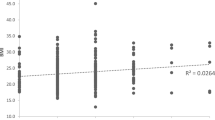Abstract
Purpose
The aim was to determine sleep quality and related factors including restless leg syndrome in the 6th year medical students and medical residents in Pamukkale University, Faculty of Medicine, Denizli, Turkey.
Methods
The data collection phase of this cross-sectional study was completed between November 1st and December 31st, 2019, with a questionnaire including 59 items. Three hundred forty-one medical students and residents participated in the study. The Pittsburgh Sleep Quality Index was used to determine the participants’ sleep quality. The International Restless Legs Syndrome Study Group Diagnostic Criteria and the Restless Leg Syndrome Rating Scale were used for the diagnosis and for determining the seriousness of restless leg syndrome, respectively.
Results
The mean age (SD ±) was 26.6 ± 3.2. Men (50%) and medical residents (59%) constituted the majority. Most of the participants (70%) had poor sleep quality, and 9% had restless leg syndrome. Despite losing their significance in multivariable analysis, a relationship existed between restless leg syndrome and sleep quality in bivariate comparisons (p = 0.04). According to the multiple variable analysis, age (p = 0.008), female gender (p = 0.04), insufficient income (p = 0.009), being on-medication (p = 0.007), being a current smoker (p = 0.01), not sleeping at the usual time (p = 0.04), and listening to music before sleeping (p = 0.03) were identified as independent risk factors for poor sleep quality.
Conclusions
The prevalence of poor sleep quality and restless leg syndrome are high in the 6th year medical students and residents. Necessary measures should be taken to reduce the effect of negative conditions on these vulnerable groups.
Similar content being viewed by others
References
Magnavita N, Garbarino S (2017) Sleep, health and wellness at work: a scoping review. Int J Environ Res Public Health 14(11):1347. https://doi.org/10.3390/ijerph14111347
Nakata A, Haratani T, Takahashi M, Kawakami N, Arito H, Kobayashi F et al (2004) Association of sickness absence with poor sleep and depressive symptoms in shift workers. Chronobiol Int 21:899–912. https://doi.org/10.1081/cbi-200038104
Magnavita N, Di Stasio E, Capitanelli I, Lops EA, Chirico F, Garbarino S (2019) sleep problems and workplace violence: a systematic review and meta-analysis. Front Neurosci 13:997. https://doi.org/10.3389/fnins.2019.00997
Curcio G, Ferrara M, De Gennaro L (2006) Sleep loss, learning capacity and academic performance. Sleep Med Rev 10:323–337. https://doi.org/10.1016/j.smrv.2005.11.001
Salminen S, Oksanen T, Vahtera J, Sallinen M, Harma M, Salo P et al (2010) Sleep disturbances as a predictor of occupational injuries among public sector workers. J Sleep Res 19:207–213. https://doi.org/10.1016/j.smrv.2005.11.001
Léger D, Partinen M, Hirshkowitz M, Chokroverty S, Hedner J (2010) Characteristics of insomnia in a primary care setting: EQUINOX survey of 5293 insomniacs from 10 countries. Sleep Med 11:987–988. https://doi.org/10.1016/j.sleep.2010.04.019
Chan-Chee C, Bayon V, Bloch J, Beck F, Giordanella JP, Leger D (2011) Epidemiology of insomnia in France. Rev Epidemiol Sante Publique 59:409–422. https://doi.org/10.1016/j.respe.2011.05.005
Ursin R, Baste V, Moen BE (2009) Sleep duration and sleep-related problems in different occupations in the Hordaland Health Study. Scand J Work Environ Health 35:193–202. https://doi.org/10.5271/sjweh.1325
Rao WW, Li W, Qi H, Hong L, Chen C, Li CY et al (2020) Sleep quality in medical students: a comprehensive meta-analysis of observational studies. Sleep Breath 24(3):1151–1165. https://doi.org/10.1007/s11325-020-02020-5
Ghalichi L, Pournik O, Ghaffari M, Vingard E (2013) Sleep quality among health care workers. Arch Iran Med 16(2):100–103
Kolo ES, Ahmed AO, Hamisu A, Ajiya A, Akhiwu BI (2017) Sleep health of healthcare workers in Kano. Nigeria Niger J Clin Pract 20(4):479–483. https://doi.org/10.4103/1119-3077.204378
Preišegolavičiūtė E, Leskauskas D, Adomaitienė V (2010) Associations of quality of sleep with lifestyle factors and profile of studies among Lithuanian students. Medicina (Kaunas) 46:482–489
Palatty PL, Fernandes E, Suresh S, Baliga MS (2011) Comparison of sleep pattern between medical and law students. Sleep Hypn 13:1–2
Corrêa CC, Oliveira FK, Pizzamiglio DS, Ortolan EVP, Weber SAT (2017) Sleep quality in medical students: a comparison across the various phases of the medical course. J Bras Pneumol 43(4):285–289. https://doi.org/10.1590/S1806-37562016000000178
Brick CA, Seely DL, Palermo TM (2010) Association between sleep hygiene and sleep quality in medical students. Behav Sleep Med 8:113–121. https://doi.org/10.1080/15402001003622925
Medeiros AL, Mendes DB, Lima PF, Araujo JF (2001) The relationships between sleepwake cycle and academic performance in medical students. Biol Rhythm Res 32:263–270
Suen LK, Hon KL, Tam WW (2008) Association between sleep behavior and sleep related factors among university students in Hong Kong. Chronobiol Int. 25:760–75. https://doi.org/10.1080/07420520802397186
Feng G, Chen J, Yang X (2005) Study on the status and quality of sleep-related influencing factors in medical college students. Zhonghua Liu Xing Bing Xue Za Zhi 26:328–331
Papp KK, Stoller EP, Sage P, Aikens JE, Owens J, Avidan A et al (2004) The effects of sleep loss and fatigue on resident-physicians: a multi-institutional, mixed-method study. Acad Med 79:394–406. https://doi.org/10.1097/00001888-200405000-00007
Puvanendran K, Venkatramani J, Jain A, Farid M (2005) Sleep deprivation in junior doctors – house officers in Singapore. Ind Health 43:129–132. https://doi.org/10.2486/indhealth.43.129
Surani AA, Surani A, Zahid S, Ali S, Farhan R, Surani S (2015) To assess sleep quality among Pakistani junior physicians (house officers): a cross-sectional study. Ann Med Health Sci Res 5:329–333. https://doi.org/10.4103/2141-9248.165246
Allen RP, Picchietti DL, Garcia-Borreguero D, Ondo WG, Walters AS, Winkelman JW et al (2014) Restless legs syndrome/Willis-Ekbom disease diagnostic criteria: updated international restless legs syndrome study group (IRLSSG) consensus criteria - history, rationale, description, and significance. Sleep Med 15(8):860–873. https://doi.org/10.1016/j.sleep.2014.03.025
Innes KE, Selfe TK, Agarwal P (2011) Prevalence of restless legs syndrome in North American and Western European populations: a systematic review. Sleep Med 12:623–634. https://doi.org/10.1016/j.sleep.2010.12.018
Merlino G, Valente M, Serafini A, Gigli GL (2007) Restless legs syndrome: diagnosis, epidemiology, classification and consequences. Neurol Sci 28(Suppl 1):S37-46. https://doi.org/10.1007/s10072-007-0736-x
Merlino G, Gigli GL (2012) Sleep-related movement disorders. Neurol Sci 33:491–513. https://doi.org/10.1007/s10072-011-0905-9
Sarıaydın M, Günay E, Ünlü, M (2018) Tıp fakültesi öğrencileri arasında huzursuz bacak sendromu sıklığı, depresyon, anksiyete ve uyku kalitesi arasındaki ilişki [Frequency of restless legs syndrome and relationship between depression, anxiety and sleep quality among medical school students]. Tuberkuloz ve toraks 66(3):217–223
Çelik N, Egici MT, Toprak D (2018) Prevalence of restless leg syndrome and sleep quality in healthcare workers. Euras J Fam Med 7:53–60
Buysse DJ, Reynolds CF 3rd, Monk TH, Berman SR, Kupfer DJ (1989) The Pittsburgh sleep quality index: a new instrument for psychiatric practice and research. Psychiatry Res 28:193–213. https://doi.org/10.1016/0165-1781(89)90047-4
Ağargün MY, Kara H, Anlar Ö (1996) Validity and reliability of Pittsburgh sleep quality index. Türk Psikiyatri Dergisi 7:107–115. Turkish
Filiz MB, Çakır T (2015) Restless leg syndrome with current diagnostic criteria. Turk J Osteoporos 21:87–95. Turkish
Sahin EM, Ozturk L, Oyekcin DG, Uludag A (2016) Effects of sleep hygiene education on subjective sleep quality and academic performance. J Clin Analytic Med 7:304–308
Saygın M, Öztürk Ö, Gonca T, Has M, Hayri UB, Kurt Y, Yağlı MA, Çalışkan S, Akkaya A, Öztürk M (2016) Investigation of sleep quality and sleep disorders in students of medicine. Turk Thorac J 17(4):132–140. Turkish
Ergin A, Aydemir-Acar G, Bekar T (2018) Determination of sleep quality of students in faculties providing health education. Pam Med J. 11(3):347–354.Turkish
Valente F, Batista C, Simões V, Tomé I, Carrilho A (2019) Quality of sleep among Portuguese anaesthesiologists: a cross-sectional study. Acta Medica Portuguesa. 32(10):641–646. https://doi.org/10.20344/amp.11468
Huen LL, Chan TW, Yu WM, Wing YK (2007) Do medical students in Hong Kong have enough sleep? Sleep Biol Rhythms 5:226–230
Giri P, Baviskar M, Phalke D (2013) Study of sleep habits and sleep problems among medical students of Pravara Institute of Medical Sciences Loni, Western Maharashtra. India Ann Med Health Sci Res 3:51–54. https://doi.org/10.4103/2141-9248.109488
Patel NP, Grandner MA, Xie D, Branas CC, Gooneratne N (2010) “Sleep disparity” in the population: poor sleep quality is strongly associated with poverty and ethnicity. BMC Public Health 10:475. https://doi.org/10.1186/1471-2458-10-475
Chehri A, Khazaie S, Noori M, Eskandari S, Khazaie H, Jalali A (2020) Sleep quality and the problems in smokers and nonsmokers: a comparative study. Journal of Substance Use 25(4):425–429
Shalash AS, Elrassas HH, Monzem MM, Salem HH, Abdel Moneim A, Moustafa RR (2015) Restless legs syndrome in Egyptian medical students using a validated Arabic version of the restless legs syndrome rating scale. Sleep Med 16:1528–1531. https://doi.org/10.1016/j.sleep.2015.07.032
Minár M, Valková PP (2013) Valkovič Prevalence and impact of restless legs syndrome in university students. Mov Disord 28:1157–1158
Ishaq M, Riaz SU, Iqbal N, Siddiqui S, Moin A, Sajjad S et al (2020) Prevalence of restless legs syndrome among medical students of Karachi: an experience from a developing country. Sleep Disord 18:7302828. https://doi.org/10.1155/2020/7302828
Sevim S, Doğu O, Camdeviren H, Bugdaycı R, Sasmaz T, Kaleagası H et al (2003) Unexpectedly low prevalence and unusual characteristics of RLS in Mersin. Turkey Neurol 61:1562–1569
Acknowledgements
We thank the 6th year medical faculty students for their support during the data collection process.
Author information
Authors and Affiliations
Contributions
NE and AE conceived and designed the study; AE, BBK, and SV acquired the data; all authors analyzed and interpreted the data; NE, BBK, and AE drafted the manuscript; NE and AE critically revised the manuscript for important intellectual content; all authors approved the version to be submitted; all authors agree to be accountable for all aspects of the work.
Corresponding author
Ethics declarations
Ethics approval
All procedures performed in studies involving human participants were in accordance with the ethical standards of the institutional and/or national research committee and with the 1964 Helsinki Declaration and its later amendments or comparable ethical standards. The study was approved by the Medical Ethics Committee of Medical Faculty in Pamukkale University (60116787–020/83245).
Informed consent
Informed consent was obtained from all individual participants included in the study.
Conflict of interest
The authors declare no competing interests.
Additional information
Publisher’s note
Springer Nature remains neutral with regard to jurisdictional claims in published maps and institutional affiliations.
Rights and permissions
About this article
Cite this article
Ergin, N., Kılıç, B.B., Ergin, A. et al. Sleep quality and related factors including restless leg syndrome in medical students and residents in a Turkish university. Sleep Breath 26, 1299–1307 (2022). https://doi.org/10.1007/s11325-021-02437-6
Received:
Revised:
Accepted:
Published:
Issue Date:
DOI: https://doi.org/10.1007/s11325-021-02437-6




